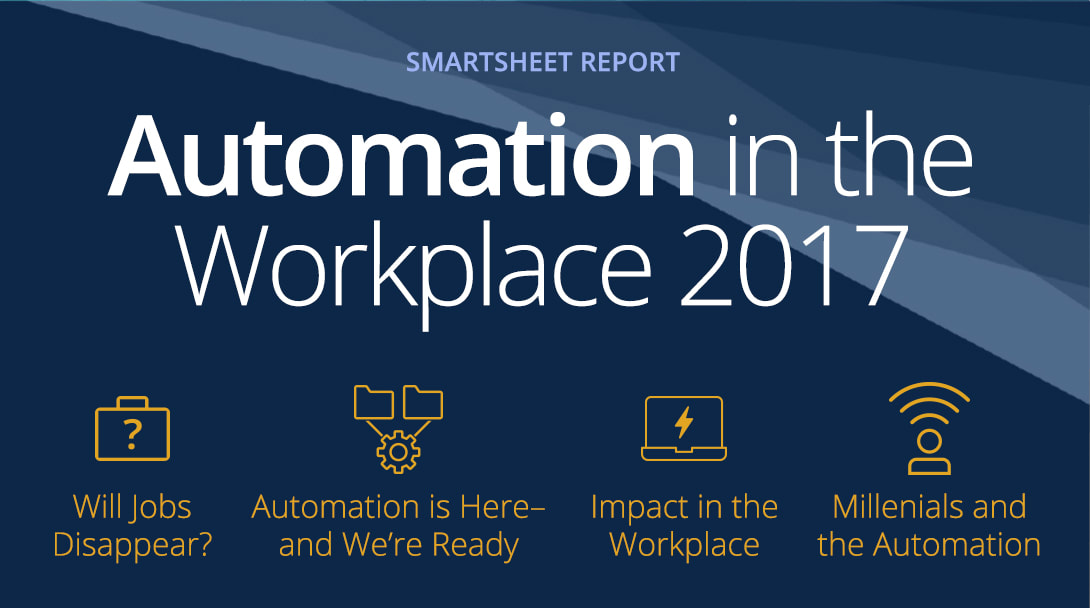|
There has been a lot of talk in the C-Suite and among IT managers about how automation can improve productivity and reduce costs. Missing from many of the conversations is how information workers view these changes, and the potential they see for automation to transform their jobs. By reducing the steps required to complete everyday tasks, automation can make information workers significantly more efficient and free up time to focus on higher-value work.
But how much of their workday is actually spent on repetitive work? Which tasks would they most like to see automated, and how do information workers believe automation will affect their lives? Is it a threat or an opportunity?
There’s been a lot of talk lately about the promise of automation to transform business, but most of the discussion has focused on self-driving cars and robots. These are significant advances, no doubt about it -- but if you focus on only these high-profile examples, you might miss a much larger opportunity: automating the repetitive work performed daily by millions of information workers.
Automation in the office isn’t new, but efforts to date have focused on a handful of key processes that are hardwired into applications. To get them up and running, the business user needs to involve IT, which adds time and expense. What’s more, the resulting solution is built for a single use case, leaving the vast majority of work in the enterprise untouched and unautomated. The far greater opportunity lies in automating the great diversity of loosely defined, unstructured work that business users perform every day, in every department. Although this has traditionally been hard to do, doing so frees up valuable time for workers to focus on higher-value work. How much time does your team actually save when you use technology to get your work done on a daily basis? The benefits of technology aren’t hard to characterize, but quantifying time savings can be, especially with emerging technology like work management platforms.
Smartsheet commissioned a study conducted by Forrester Consulting1 this past summer to quantify the total economic impact for enterprise customers, and the findings are significant: As shown by a composite organization, Smartsheet helps business leaders improve their productivity by 15% – saving over 300 hours each year. Employees and the C-suite often struggle to cope with an abundance of tools meant to facilitate better collaboration. Yet even with so many tools, nothing seems to be in the right place and the tools (e.g., email, online chat, file sharing) don’t always work well together. As a result, many employees give up and default to the tool they are most familiar with: Email.
Email will never go away, but we need to look at how we can give people better choices for working together. Until they have access to better tools, employees won’t switch from email because people cling to the familiar. Additionally, the chaos created by too many collaboration tools imposes a tax on productivity. But bringing order to this chaos is possible by looking to the cloud. A cloud-based work management solution provides a single workspace that streamlines and centralizes collaboration with tools that are intuitive and flexible for workers, both internal and external. Is your organization ready to collaborate in a new way? Time spent on routine tasks reduces your ability to focus on solving problems or innovating for your business. Managing updates, status reports, and approvals is time consuming and repetitive, not to mention disjointed and error-prone. Often, the updates and approvals you need to move work forward get lost in your email inbox, or requests get lost in someone else’s.
We are excited to introduce three powerful new capabilities in Smartsheet: Automated Actions to eliminate routine tasks, freeing you to focus on higher value work; Smartsheet notification center to make it easier to stay up to date; and an all-new mobile app to help you, your team, and your stakeholders move work forward from anywhere. Early in my career, I saw compliance as a tax on moving quickly that a small, growing engineering team couldn’t afford. I’m still not a hardcore compliance guy, but I have come to see the value of building compliance into a product early.
Engineering teams need to work differently to meet requirements around compliance. If you put the right things in place early on, the technical debt imposed by compliance is not very significant, whereas if you have to play catch up later, you’ll have a lot of work to do at the expense of other things you could accomplish. |
|
Care line: +603-9212 0157
|
Leave us your inquiry |
|
This company is registered with the Ministry of Finance, Malaysia.
Equip your organisation with digital solutions & training that inspire innovation and joy at work. Copyright © 2024 57Network Consultancy Sdn. Bhd. Company Registration number : 202001020346 (1376666-K) All rights reserved. |








